Table of Contents
ToggleIntroduction
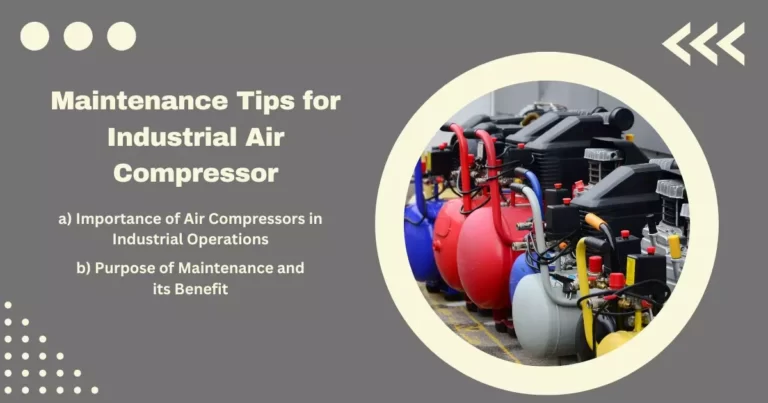
a) Importance of Air Compressors in Industrial Operations
Air compressors are essential components in numerous industrial operations, as they provide a reliable and constant supply of compressed air to power a diverse range of pneumatic tools and equipment. Used across various sectors, such as manufacturing, construction, automotive, and pharmaceutical industries, these versatile machines have become indispensable for maintaining high levels of productivity and efficiency in today’s fast-paced industrial landscape.
b) Purpose of Maintenance and its Benefits
Given the crucial role that Air compressors play in industrial processes, regular maintenance is of paramount importance. The primary purpose of maintenance is to ensure the optimal performance and longevity of these machines. By performing routine checks and preventative measures, businesses can reduce the risk of unexpected breakdowns, minimize operational costs, and enhance overall efficiency. In the following sections, we will delve deeper into the importance of air compressors in industrial operations and explore the numerous benefits that proper maintenance brings to the table.
Understanding Industrial Air Compressors
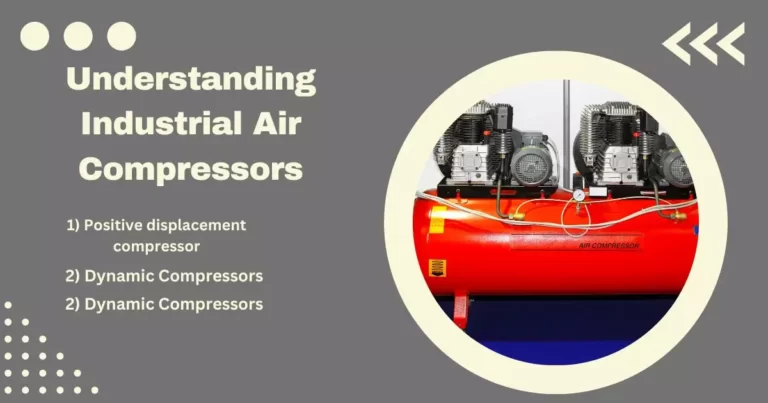
A) Types of Air Compressors and Their Applications
Positive displacement compressors and dynamic compressors are the two basic types of air compressors that can be generally classed.
1) Positive displacement compressors:
These compressors increase the pressure of the air by mechanically lowering its volume. They are additionally divided into:
a) Reciprocating Compressors: also referred to as piston compressors, compress air by moving a piston inside a cylinder. They are frequently employed in tiny industrial, woodworking, and automotive applications.
b) Rotary Screw Compressors: To compress air, these compressors use two interlocking helical screws known as rotors. In continuous operation applications like manufacturing and heavy industrial processes, they are frequently used.
c) Rotary Vane Compressors: To capture and compress air, these compressors use a rotor with several sliding vans. They are appropriate for applications with low to medium airflow demands, like small-scale manufacturing and vehicle repair facilities.
2) Dynamic Compressors:
Dynamic compressors work by transferring kinetic energy to the air, which is then transformed into potential energy in the form of pressure. The primary types consist of:
a) Centrifugal compressors: These compressors pressurize air by accelerating it with a rotating impeller and then decelerating it with a diffuser. They are perfect for large-scale activities including power plants, chemical processing plants, and oil refineries.
b) Axial Compressors: These compressors increase pressure by accelerating air in a straight line using rotating airfoils. They are frequently utilized in high-flow applications like gas turbines and airplane engines.
B) Air compressor components and their uses
There are various essential parts that make up an air compressor, each serving a particular purpose:
- Compressor: The main element that compresses the air and raises its pressure is the compressor. The application and necessary pressure determine the kind of compressor that is utilized.
- Motor: The compressor is driven by a motor, which supplies the force needed to compress the air. Diesel, gasoline, or electricity can all be used to power motors.
- Air Intake Filter: To ensure clean, compressed air, this part filters the incoming air to remove dust and other impurities.
- Pressure Switch: To maintain the desired pressure level, this component automatically turns the motor on and off while monitoring the air pressure in the tank.
- Storage Tank: By keeping the compressed air here, you can use it whenever you need and at a constant pressure.
- Pressure Relief Valve: This safety device lets out extra pressure when the tank’s pressure rises above a certain threshold, preventing damage or mishaps.
- Check valve: When the motor is stopped, this part keeps compressed air from returning to the compressor.
- Air Dryer: This optional part, the air dryer, removes moisture from compressed air, which is crucial for applications that call for dry air.
- Lubrication System: This part ensures that the compressor’s moving parts are properly lubricated, preventing wear and tear and extending machine life.
Maintenance Schedule and Checklist
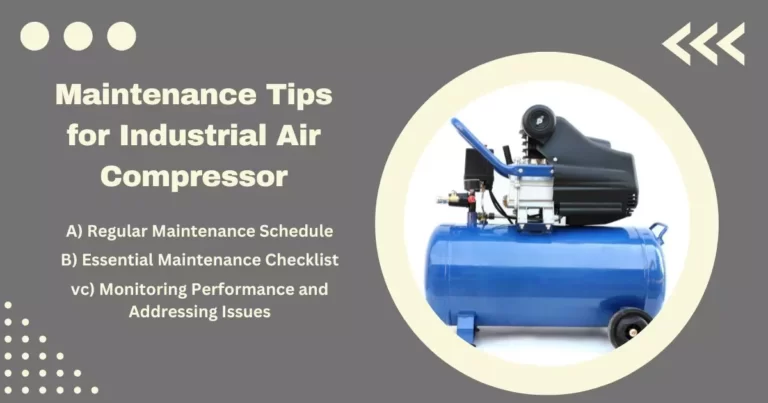
A) Regular Maintenance Schedule
A well-structured maintenance schedule is essential for keeping air compressors in optimal working condition. Here is a general outline of regular maintenance tasks:
- Daily:
- Check oil levels (if applicable) and refill as needed
- Inspect and drain condensate from the storage tank
- Weekly:
- Clean the air intake filter
- Check for air leaks and repair them as needed
- Inspect hoses, fittings, and connections for wear or damage
- Monthly:
- Check belts for wear and tension, adjusting or replacing them as necessary
- Inspect and clean heat exchangers (if applicable)
- Quarterly:
- Replace air intake filters
- Check and replace lubricants (if applicable)
- Inspect, clean or replace pressure relief valves
- Annually:
- Replace air dryer filters (if applicable)
- Inspect and service the motor
- Check and replace worn or damaged components
This schedule is a general guideline. Always consult the manufacturer’s recommendations for your specific air compressor model.
B) Essential Maintenance Checklist
An effective maintenance checklist should cover the following aspects:
- Compressor and motor: Inspect for signs of wear, damage, or leaks; check oil levels and lubrication systems.
- Air intake filter r: Clean or replace as needed to ensure efficient airflow.
- Storage tank: Drain condensate and inspect for corrosion or damage.
- Pressure switch: Verify proper operation and adjust settings if necessary.
- Pressure relief valve: Check for proper function and replace if worn or damaged.
- Check valve: Inspect for leaks and ensure proper operation.
- Hoses, fittings, and connections: Check for wear, damage, or leaks and repair or replace as needed.
- Belts: Inspect for wear and proper tension; adjust or replace as necessary.
- Lubricants: Check levels and replace them according to the manufacturer’s guidelines.
- Air dryer: Inspect and replace filters as needed to maintain dry air.
c) Monitoring Performance and Addressing Issues
Regularly monitoring the performance of your air compressor can help identify potential issues before they become critical problems. Keep an eye on the following indicators:
- Pressure fluctuations: If pressure levels are inconsistent, it may indicate leaks, worn components, or a malfunctioning pressure switch.
- Increased energy consumption: A sudden increase in energy usage could signify inefficiencies or mechanical issues within the compressor system.
- Excessive noise or vibration: unusual noises or vibrations may be signs of wear, misalignment, or loose components.
- Decreased airflow: Reduced airflow can be caused by clogged filters, leaks, or worn components.
By addressing these issues promptly and following a regular maintenance schedule, you can ensure the optimal performance and longevity of your air compressor.
Safety Precautions
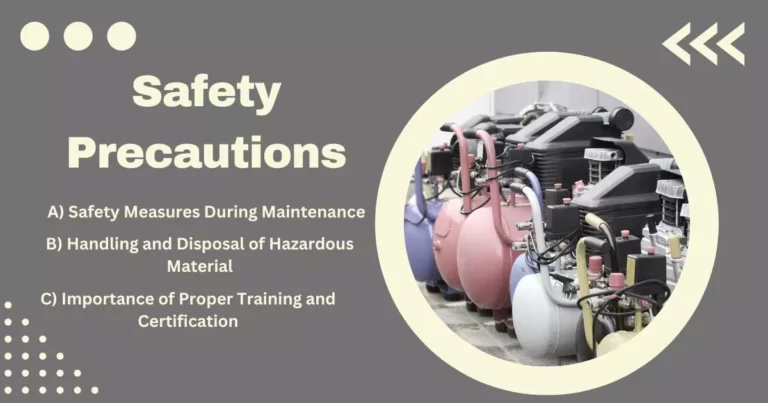
A) Safety Measures During Maintenance
Use the following precautions when servicing air compressors to protect your safety:
Disconnect the air compressor from its power supply before beginning any maintenance to avoid unintentional start-ups.
- Reduce the system’s pressure: To reduce the risk of injury, release any remaining pressure in the storage tank and its lines.
- PPE (personal protective equipment) should be worn as necessary This might include closed-toed shoes, gloves, safety goggles, and hearing protection.
- Use the right tools: Use the appropriate tools and machinery for each maintenance work to avoid damage and lower the possibility of accidents.
- obey the instructions from the manufacturer: Always follow the manufacturer’s recommended upkeep guidelines and schedules for air compressors.
- Air out the space: To prevent the accumulation of dangerous gases or vapors, make sure the workspace has appropriate ventilation.
B) Handling and Disposal of Hazardous Materials
Hazardous substances like lubricants, solvents, or filters may need to be handled and disposed of as part of some air compressor maintenance chores. Observe these recommendations for secure handling and disposal:
- Materials should be stored in the proper containers: To avoid spills or leaks, use containers that are suitable for the hazardous item and are well sealed.
- container labels: All containers should be clearly marked with the type of material inside and any required hazard warnings.
- Adhere to local laws: Follow local environmental laws and regulations regarding how to dispose of dangerous waste. This could entail transporting the materials to a specified disposal site or setting up a pickup by a registered waste disposal company.
- Use proper PPE: Wear proper PPE, such as gloves, goggles, and protective clothing, when handling hazardous materials to reduce exposure and prevent harm.
- Put spill containment measures into action: In case of inadvertent spills, keep spill containment supplies on hand, such as absorbent pads or spill kits
C) Importance of Proper Training and Certification
For a number of reasons, it is essential to guarantee that those in charge of performing air compressor repair have the appropriate training and certification.
- Safety: Trained professionals are better suited to perform maintenance work in a safe manner, lowering the likelihood of mishaps or injuries.
- Efficiency: With the right training, maintenance chores may be carried out more quickly, reducing downtime and ensuring optimum compressor performance.
- Savings: Skilled technicians are better able to identify problems and take action, which lowers the probability of expensive repairs or early equipment failure.
- Regulatory compliance: To work on air compressors or handle hazardous products, technicians may need to possess special credentials or qualifications in various sectors or locales.
In addition to fostering a safer work environment, investing in the right training and certification for your maintenance personnel improves the overall effectiveness and dependability of your air compressor system.
Lubrication System Maintenance
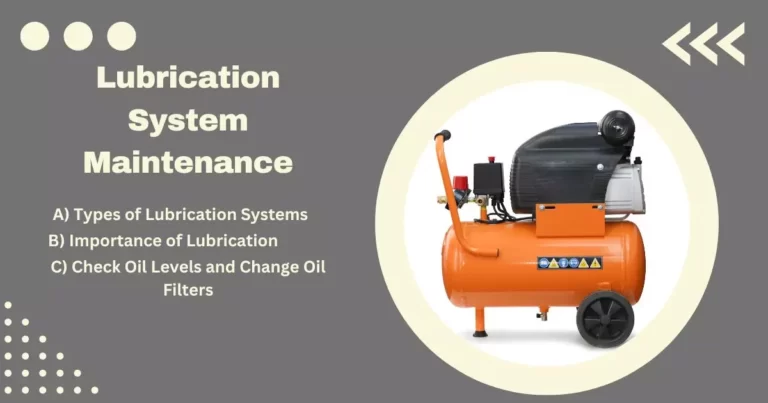
A) Types of Lubrication Systems
Air compressor lubrication systems can be classified into two main types:
- Oil-lubricated: In this system, oil is used to lubricate the moving parts of the compressor, such as pistons, rotors, or bearings. The oil also helps dissipate heat, which is generated during the compression process. Oil-lubricated compressors require regular oil changes and maintenance to ensure optimal performance.
- Oil-free: These compressors use non-contact bearings or special coatings to eliminate the need for oil as a lubricant. While oil-free compressors generally require less maintenance than their oil-lubricated counterparts, they may still require periodic servicing to ensure the proper functioning of the non-contact bearings or other wear-resistant components.
B) Importance of Lubrication
Proper lubrication is critical for air compressors for several reasons:
- Reduced friction: Lubrication minimizes friction between moving parts, reducing wear and tear, and prolonging the life of the compressor.
- Heat dissipation: Lubricants help to remove excess heat generated during the compression process, preventing overheating and potential damage to the compressor components.
- Corrosion protection: Lubricants can provide a protective barrier, preventing corrosion and damage to the compressor’s metal components.
- Improved efficiency: A well-lubricated compressor runs more smoothly, resulting in better performance and energy efficiency.
C) Check Oil Levels and Change Oil Filters
For oil-lubricated air compressors, it is essential to check oil levels and change oil filters regularly to maintain optimal performance. Here are some guidelines for these tasks:
- Check oil levels: Most air compressors have an oil sight glass or dipstick to check the oil level. It is recommended to check the oil level daily, or according to the manufacturer’s guidelines, and top off as needed. Ensure that the compressor is turned off and depressurized before checking the oil level. Use the recommended type of oil specified by the manufacturer.
- Changing oil filters: Over time, oil filters can become clogged with debris and contaminants, reducing the effectiveness of the lubrication system. Replace the oil filter according to the manufacturer’s recommended intervals or when the filter becomes dirty or clogged. When changing the oil filter, also consider changing the oil to ensure optimal performance and protection for the compressor components.
By following these guidelines and adhering to the manufacturer’s recommendations for lubrication system maintenance, you can help ensure the longevity, efficiency, and reliability of your air compressor.
Air Filtration Maintenance
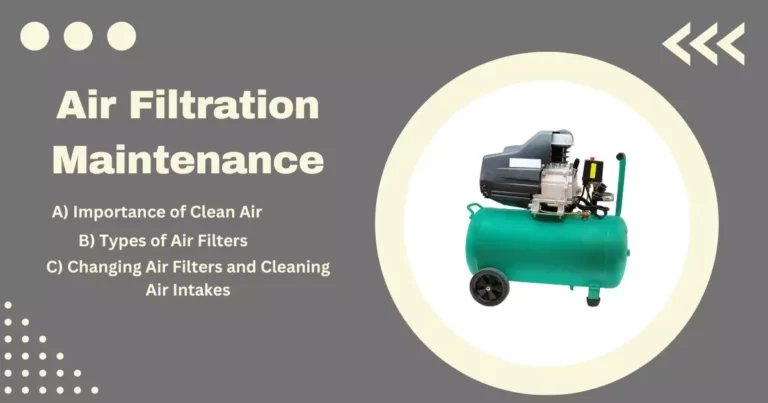
A) Importance of Clean Air
For air compressors to operate properly, clean air is essential. The compressor’s internal components are susceptible to serious damage from airborne impurities such as dust, grime, and moisture, which lowers the compressor’s performance and lifespan. The longevity and best performance of the compressor depend on maintaining clean air.
B) Types of Air Filters
There are two primary categories of air filters used in air compressors:
Before the air enters the compressor, these filters clean the outside air of any airborne contaminants. They are essential for maintaining the compressor’s performance and avoiding damage to its internal parts. Intake air filters are normally disposable and can be made of a variety of materials, including paper, foam, or synthetic fibers.
Inline air filters: These filters are used to clean compressed air of contaminants such as oil, moisture, and other impurities before it is delivered to pneumatic tools and equipment. They are situated downstream of the compressor. Inline air filters are frequently replaced and can be constructed from a variety of materials, including ceramic, activated carbon, or synthetic fibers.
C) Changing Air Filters and Cleaning Air Intakes
For air compressors to operate at their best and to keep clean air, regular air filter changes and air intake cleaning are necessary. For these tasks, consider the following guidelines:
Changing air filters: Change the intake of air filters at the manufacturer’s suggested intervals. Generally speaking, intake air filters should be changed every three to six months, or more frequently in dusty or humid areas. Replace the filter by removing the filter housing, depressurizing the compressor, and installing a fresh filter of the same type.
Cleaning air intakes: Look for any accumulation of dust or other material that can obstruct airflow. Remove any debris with pressurized air or a vacuum, being cautious not to harm the filter or the intake grille. Make sure the intake grille is spotless and unobstructed.
For air compressors to perform at their peak and last as long as possible, regular maintenance of air filters and air intakes is essential. Businesses may reduce the risk of damage to the compressor’s internal components and ensure effective and dependable operation by following manufacturer instructions and maintaining clean intake air.
FAQ
Most frequent questions and answers
For your industrial air compressor to run well and last a long time, regular maintenance is crucial. It is advised to perform a visual inspection each day, listen for leaks or strange noises, and keep an eye on the system pressure. According to the manufacturer’s recommendations, routine maintenance chores like changing the oil and air filters should be carried out every 3 to 6 months, while more involved maintenance chores like replacing belts and valves should be done once a year.
The following are some typical indications that your industrial air compressor may require maintenance:
reduced effectiveness or air pressure
Unusual vibrations or noises
The compressed air contains too much oil or moisture. Safety devices frequently trip due to overheating.
leaks in the air fittings, seals, or lines
Corrosion, equipment damage, and decreased efficiency can all be caused by moisture buildup. Install an air dryer and use drain valves to drain the system of water to reduce moisture in your compressed air system. Check the compressed air’s moisture level on a regular basis and make sure the air dryer is working properly. Additionally, a clean, dry, and well-ventilated area is ideal for installing your air compressor, which can aid in lowering the danger of moisture accumulation.
An industrial air compressor’s lifetime and effective functioning depend on proper lubrication. Lubrication minimizes wear and friction, avoids overheating, and shields interior parts from harm. Utilizing the proper lubricant, as recommended by the manufacturer, and adhering to the suggested lubrication schedule are crucial. To guarantee optimal operation, check the oil level frequently and replace it as directed by the manufacturer.
Although the end user can perform some simple maintenance procedures like visual inspections and filter replacements, more difficult procedures like repairing or replacing internal components should be left to qualified professionals. Hiring a professional lowers the chance of additional damage or issues by ensuring that your equipment is serviced appropriately and safely. Regular expert maintenance can extend the life of your industrial air compressor by identifying possible problems before they require expensive repairs.












